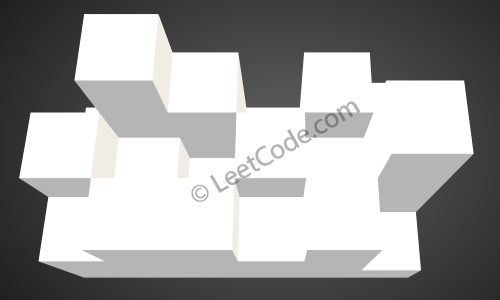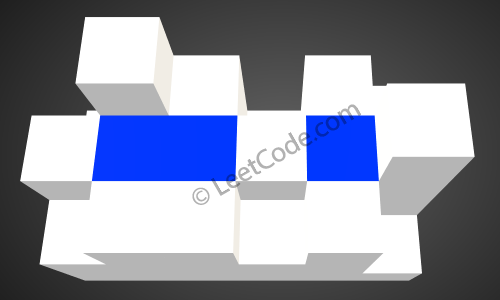LeetCode Weekly Contest 6
2016-09-25 21:07
351 查看
leetcode现在每周末举办比赛,这是今天上午参加的比赛的题解。
题目难度不算大,两个easy,一个medium,一个hard。hard题之前接触过,所以做得比较顺利。
1. Sum of Left Leaves(Leetcode 404 Easy)
Find the sum of all left leaves in a given binary tree.
Example:
分析:比较简单的二叉树问题。二叉树问题大部分用递归就能解决,本题就是traverse的变形,这里加一个flag判断是左子树还是右子树即可。
代码:
2. Convert a Number to Hexadecimal (Leetcode 405 Easy)
Given an integer, write an algorithm to convert it to hexadecimal. For negative integer, two’s complement method is used.
Note:
All letters in hexadecimal (
The hexadecimal string must not contain extra leading
The given number is guaranteed to fit within the range of a 32-bit signed integer.
You must not use any method provided by the library which converts/formats the number to hex directly.
Example 1:
Example 2:
分析:十六进制的转换,搞清楚负数补码的原理就可以(拿0x100000000 + x即可),注意存的时候用一下long long防止整数溢出。
代码:
3. Queue Reconstruction by Height (LeetCode406 Medium)
Suppose you have a random list of people standing in a queue. Each person is described by a pair of integers
Note:
The number of people is less than 1,100.
Example
分析:题意是给出人的高度和该高度前面有多少个人,重拍序列满足这一要求。
把序列中的人按照高度从高到低排序,高度一样的前面人越少的越靠前。这样以此处理每一个点,
按照people[i].second中存的有几个比他高来判断他应该在第几个位置插入(比该点高的点已经都进入序列了),处理完毕后即满足要求。
代码:(比较函数用了C++11中的lambda表达式)
4. Trapping Rain Water II (Leetcode 407 Hard)
Given an
Note:
Both m and n are less than 110. The height of each unit cell is greater than 0 and is less than 20,000.
Example:

The above image represents the elevation map

After the rain, water are trapped between the blocks. The total volume of water trapped is 4.
分析:
维护一个最小堆和一个记录访问与否的数组flag[m]
, 把图中外层一圈元素存入堆中,flag相应标记。
然后开始如下循环:
拿出其中堆顶元素(temp),BFS的方法查看其四周的四个点,
如果存在高度比temp低的点(heightMap[nx][ny]),则temp.h - heightMap[nx][ny]这段高度肯定可以储水。
然后把nx,ny位置的点加入堆中(但其高度应改为temp.h,多出部分已经储水记录过),并更新flag。
对于高度比temp高的点,直接加入堆中,并更新flag即可。
这样当堆中为空处理完所有点后,结果即为储水的值。
代码:
题目难度不算大,两个easy,一个medium,一个hard。hard题之前接触过,所以做得比较顺利。
1. Sum of Left Leaves(Leetcode 404 Easy)
Find the sum of all left leaves in a given binary tree.
Example:
3 / \ 9 20 / \ 15 7 There are two left leaves in the binary tree, with values 9 and 15 respectively. Return 24.
分析:比较简单的二叉树问题。二叉树问题大部分用递归就能解决,本题就是traverse的变形,这里加一个flag判断是左子树还是右子树即可。
代码:
/**
* Definition for a binary tree node.
* struct TreeNode {
* int val;
* TreeNode *left;
* TreeNode *right;
* TreeNode(int x) : val(x), left(NULL), right(NULL) {}
* };
*/
class Solution {
private:
int result = 0;
void traverse(TreeNode* root, int flag) {
if (root == nullptr) {
return;
}
if (root -> left == nullptr && root -> right == nullptr && flag == -1) {
result += root -> val;
return;
}
traverse(root -> left, -1);
traverse(root -> right, 1);
}
public:
int sumOfLeftLeaves(TreeNode* root) {
traverse(root, 0);
return result;
}
};2. Convert a Number to Hexadecimal (Leetcode 405 Easy)
Given an integer, write an algorithm to convert it to hexadecimal. For negative integer, two’s complement method is used.
Note:
All letters in hexadecimal (
a-f) must be in lowercase.
The hexadecimal string must not contain extra leading
0s. If the number is zero, it is represented by a single zero character
'0'; otherwise, the first character in the hexadecimal string will not be the zero character.
The given number is guaranteed to fit within the range of a 32-bit signed integer.
You must not use any method provided by the library which converts/formats the number to hex directly.
Example 1:
Input: 26 Output: "1a"
Example 2:
Input: -1 Output: "ffffffff"
分析:十六进制的转换,搞清楚负数补码的原理就可以(拿0x100000000 + x即可),注意存的时候用一下long long防止整数溢出。
代码:
class Solution {
public:
string toHex(int num) {
string result;
long long num2 = num;
char hex[16] = {'0','1','2','3','4','5','6','7','8','9','a','b','c','d','e','f'};
if (num2 < 0) {
num2 = 0x100000000 + num2;
}
if (num2 == 0) {
result += '0';
return result;
}
while (num2 != 0) {
result = hex[num2 % 16] + result;
num2 /= 16;
}
return result;
}
};3. Queue Reconstruction by Height (LeetCode406 Medium)
Suppose you have a random list of people standing in a queue. Each person is described by a pair of integers
(h, k), where
his the height of the person and
kis the number of people in front of this person who have a height greater than or equal to
h. Write an algorithm to reconstruct the queue.
Note:
The number of people is less than 1,100.
Example
Input: [[7,0], [4,4], [7,1], [5,0], [6,1], [5,2]] Output: [[5,0], [7,0], [5,2], [6,1], [4,4], [7,1]]
分析:题意是给出人的高度和该高度前面有多少个人,重拍序列满足这一要求。
把序列中的人按照高度从高到低排序,高度一样的前面人越少的越靠前。这样以此处理每一个点,
按照people[i].second中存的有几个比他高来判断他应该在第几个位置插入(比该点高的点已经都进入序列了),处理完毕后即满足要求。
代码:(比较函数用了C++11中的lambda表达式)
class Solution {
public:
vector<pair<int, int>> reconstructQueue(vector<pair<int, int>>& people) {
vector<pair<int, int>> result;
sort(people.begin(), people.end(), [](const pair<int, int>& p1, const pair<int, int>& p2)
{
if (p1.first == p2.first) {
return p1.second < p2.second;
}
else return p1.first > p2.first;
} );
for (int i = 0; i < people.size(); ++i) {
result.insert(result.begin() + people[i].second, people[i]);
}
return result;
}
};4. Trapping Rain Water II (Leetcode 407 Hard)
Given an
m x nmatrix of positive integers representing the height of each unit cell in a 2D elevation map, compute the volume of water it is able to trap after raining.
Note:
Both m and n are less than 110. The height of each unit cell is greater than 0 and is less than 20,000.
Example:
Given the following 3x6 height map: [ [1,4,3,1,3,2], [3,2,1,3,2,4], [2,3,3,2,3,1] ] Return 4.

The above image represents the elevation map
[[1,4,3,1,3,2],[3,2,1,3,2,4],[2,3,3,2,3,1]]before the rain.

After the rain, water are trapped between the blocks. The total volume of water trapped is 4.
分析:
维护一个最小堆和一个记录访问与否的数组flag[m]
, 把图中外层一圈元素存入堆中,flag相应标记。
然后开始如下循环:
拿出其中堆顶元素(temp),BFS的方法查看其四周的四个点,
如果存在高度比temp低的点(heightMap[nx][ny]),则temp.h - heightMap[nx][ny]这段高度肯定可以储水。
然后把nx,ny位置的点加入堆中(但其高度应改为temp.h,多出部分已经储水记录过),并更新flag。
对于高度比temp高的点,直接加入堆中,并更新flag即可。
这样当堆中为空处理完所有点后,结果即为储水的值。
代码:
class Solution {
private:
struct node {
int x, y, h;
node(int nx, int ny, int nh):x(nx), y(ny), h(nh){}
};
int dx[4] = {-1,0,0,1};
int dy[4] = {0,1,-1,0};
struct cmp {
bool operator() (const node &n1, const node &n2) {
return n1.h > n2.h;
}
};
public:
int trapRainWater(vector<vector<int>>& heightMap) {
if (heightMap.size() == 0) {
return 0;
}
int m = heightMap.size(), n = heightMap[0].size();
int flag[m]
= {0};
int result = 0;
priority_queue<node, vector<node>, cmp> que;
for (int i = 0; i < m; ++i) {
que.push(node(i,0, heightMap[i][0]));
flag[i][0] = 1;
que.push(node(i,n - 1, heightMap[i][n - 1]));
flag[i][n - 1] = 1;
}
for (int i = 1; i < n - 1; ++i) {
que.push(node(0,i,heightMap[0][i]));
flag[0][i] = 1;
que.push(node(m - 1, i,heightMap[m - 1][i]));
flag[m - 1][i] = 1;
}
while (!que.empty()) {
node temp = que.top();
que.pop();
for (int i = 0; i < 4; ++i) {
int nx = temp.x + dx[i], ny = temp.y + dy[i];
if (nx >= 0 && nx < m && ny >= 0 && ny < n && !flag[nx][ny]) {
result += max(0, temp.h - heightMap[nx][ny]);
que.push(node(nx, ny, max(temp.h, heightMap[nx][ny])) );
flag[nx][ny] = 1;
}
}
}
return result;
}
};
相关文章推荐
- LeetCode Weekly Contest 23 之 539. Minimum Time Difference
- 【LeetCode】LeetCode Weekly Contest 16B
- LeetCode Weekly Contest 25 之 537.Complex Number Multiplication
- LeetCode Weekly Contest 13-HammingDistance【易】
- LeetCode Weekly Contest 40(2) - Solve the Equation
- leetcode weekly contest 61 ( 738. Monotone Increasing Digits )
- LeetCode Weekly Contest 23
- LeetCode Weekly Contest 13-TotalHamming Distance【中】
- LeetCode Weekly Contest 47
- LeetCode Weekly Contest 45解题思路
- LeetCode Weekly Contest 13-Matchsticks to Square【中】
- LeetCode Weekly Contest 33解题思路
- LeetCode Weekly Contest 36解题思路
- 73th LeetCode Weekly Contest Escape The Ghosts
- LeetCode Weekly Contest 26解题思路
- LeetCode Weekly Contest 27
- LeetCode 650 2 Keys Keyboard - LeetCode Weekly Contest 43
- LeetCode Weekly Contest 56 Find K-th Smallest Pair Distance
- LeetCode Weekly Contest 37解题思路
- 73th LeetCode Weekly Contest Domino and Tromino Tiling
